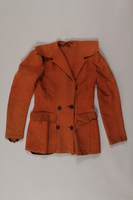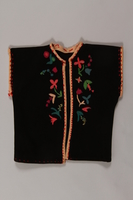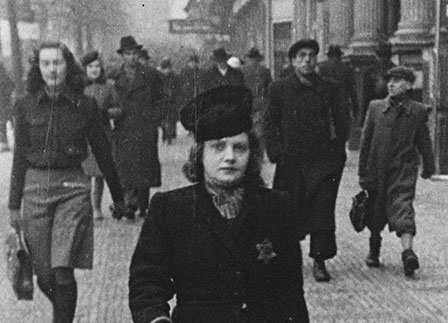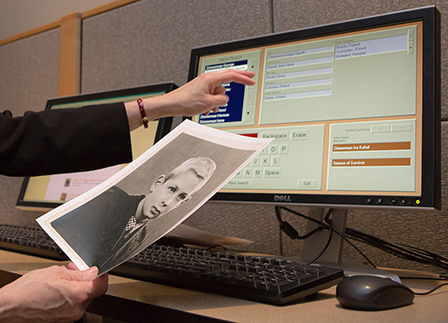Overview
- Description
- Consists of photographs and documents from the collection of David and Lisa Eizenberg. Includes photographs of David's work with the Joint Distribution Committee and HIAS in displaced persons camps near Berlin following World War II; of the voyage of the Champollion, which brought displaced persons--including a large group of children to Palestine in April 1946; pre-war family photographs; and some prints published by George Kadish of images from the Stroop Report. Also includes David Eizenberg's 1946 passport; copies of personal correspondence; and letter from the Jewish Agency noting that David Eisenberg [sic} will accompany the Champollion.
- Date
-
inclusive:
1930-1953
bulk: 1945-1948
- Credit Line
- United States Holocaust Memorial Museum Collection, Gift of the family of David and Lisa Eizenberg
- Collection Creator
- David Eizenberg
- Biography
-
David Eizenberg was born in 1911 in eastern Poland (now Ukraine) and immigrated to the United States at age 11. During World War II, he trained at Camp Ritchie, and, in his role as a technical sergeant, set up communications for, among other events, the Potsdam Conference. After the war, he worked for the Joint Distribution Committee and HIAS in displaced persons camps and accompanied the children going to Palestine on the ship Champollion. While assisting displaced persons searching for relatives, he met Lisa Egler (b. May 19, 1924). She was half-Jewish and had been active in the Red Orchestra. The couple later married.
Physical Details
- Extent
-
3 folders
Rights & Restrictions
- Conditions on Access
- There are no known restrictions on access to this material.
- Conditions on Use
- Material(s) in this collection may be protected by copyright and/or related rights. You do not require further permission from the Museum to use this material. The user is solely responsible for making a determination as to if and how the material may be used.
Keywords & Subjects
- Personal Name
- Eizenberg, David. Eizenberg, Lisa.
- Corporate Name
- American Jewish Joint Distribution Committee HIAS (Agency)
Administrative Notes
- Holder of Originals
-
United States Holocaust Memorial Museum
- Legal Status
- Permanent Collection
- Provenance
- Nina Schuessler and Michael Eizenberg donated their parents' collection to the United States Holocaust Memorial Museum in 2015.
- Record last modified:
- 2023-08-24 13:46:46
- This page:
- http://collections.ushmm.org/search/catalog/irn96135
Download & Licensing
- In Copyright - Use Permitted
- Terms of Use
- This record is not digitized and cannot be downloaded online.
In-Person Research
- Request 7 Days in Advance of Visit
- Plan a Research Visit
-
Request in Shapell Center Reading Room
Bowie, MD
Contact Us
Also in David and Lisa Eizenberg collection
The collection consists of a coat, vest, documents, and photographs relating to the experiences of David and Lisa Eizenberg before and after the war in Germany when David worked with the Joint Distribution Committee and HIAS assisting displaced persons in Germany and Palestine.
Date: 1930-1958

Coat worn by a female German Jewish member of the Red Orchestra resistance group
Object
Coat worn by Lisa Gervai-Egler, probably postwar when she returned to Berlin after being liberated from a concentration camp. During the war, while Lisa was a student at the Berlin Museum School of Fine Arts, she joined an anti-Nazi resistance movement known as the Rote Kapelle (Red Orchestra). This group smuggled coded messages on troop movements and other strategic information to the Russian Front. Lisa was captured while on a mission in Poland and imprisoned by the Germans. Toward the end of the war, she met an American soldier, David Eizenberg, who was serving as a Russian translator. David remained in Germany after the war ended in May 1945, working with the Joint Distribution Committee and HIAS in displaced persons camps near Berlin. He and Lisa met again and married in 1946.

Vest worn by a female German Jewish member of the Red Orchestra resistance group
Object
Vest worn by Lisa Gervai-Egler, probably postwar, when she returned to Berlin after being liberated from a concentration camp. During the war, while Lisa was a student at the Berlin Museum School of Fine Arts, she joined an anti-Nazi resistance movement known as the Rote Kapelle (Red Orchestra). This group smuggled coded messages on troop movements and other strategic information to the Russian Front. Lisa was captured while on a mission in Poland and imprisoned by the Germans. Toward the end of the war, she met an American soldier, David Eizenberg, who was serving as a Russian translator. David remained in Germany after the war ended in May 1945, working with the Joint Distribution Committee and HIAS in displaced persons camps near Berlin. He and Lisa met again and married in 1946.



